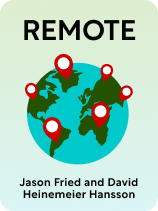

This article is an excerpt from the Shortform book guide to "Remote" by Jason Fried and David Heinemeier Hansson. Shortform has the world's best summaries and analyses of books you should be reading.
Like this article? Sign up for a free trial here.
Do remote workers just watch TV all day? How important is company culture?
When it comes to remote work, many companies are hesitant to adopt the practice because of common myths about remote work. In their book Remote, Fried and Hansson discuss and debunk those myths.
Keep reading to learn why remote work is a good option for employers.
Common Myths About Remote Work
Despite the benefits, you might face resistance when proposing remote work in your organization. People often have deep-seated beliefs about how work “should” be done. Fried and Hansson argue that most come from outdated assumptions that don’t hold up against evidence and practical experience. By addressing these common concerns with practical solutions rather than dismissing them, you can help your organization move past resistance and embrace the benefits of remote work.
1. There Is No Company Culture
The first myth about remote work is that it will erode company culture. It assumes that culture grows mainly through physical proximity and spontaneous conversations by the coffee machine. However, Fried and Hansson challenge this assumption, pointing out that plenty of in-office cultures aren’t particularly strong, even with everyone spending 40+ hours a week in the same building. That’s because real culture comes from your organization’s values and practices, and how people interact—not just from sharing an office.
Remote culture feels different, but it can be just as strong or even stronger when you nurture it intentionally. The authors recommend several approaches:
- Clearly define and frequently reinforce your company values in communications and decisions.
- Create dedicated virtual spaces for both work discussions and casual conversations.
- Establish meaningful traditions that connect your team, like virtual celebrations or occasional in-person gatherings.
- Show (don’t just tell) what healthy communication looks like by modeling it yourself.
| Building Community at Work Americans spend roughly a third of their adult lives at work, making it a crucial source of social connection and belonging. Yet despite their central role in our social lives, traditional office environments often fail to deliver meaningful community. Even before the pandemic, only 30% of US workers reported having a best friend at work, and by 2022, a whopping 58% of Americans reported feeling lonely—far more than the 46% who felt that way in 2018. This supports Fried and Hansson’s assertion that company culture isn’t built through physical proximity, but through shared values, meaningful practices, and intentional human connection. Research confirms this principle: A 2024 study of 1,000 knowledge workers found that while remote workers reported more loneliness than on-site workers, factors like the number of social events at work and the level of each person’s extroversion had a more significant effect on whether they felt lonely than their work location did. Experts say organizations can build strong remote cultures by focusing on what actually creates connection: First, deliberately define and reinforce your values. People who say they don’t feel lonely at work consistently describe their organizations as “inclusive,” “welcoming,” and “caring.” However, these values must be actively discussed and modeled, not just posted on your company’s website. This might mean making personal (and persistent) efforts to include everyone, which can help to draw even the most reserved workers out of their shells. Second, create dedicated spaces for social connection. Experts say the most effective activities aren’t elaborate: Free lunches together, time for personal chitchat in meetings, and casual happy hours consistently rank highest in effectively building connections across all personality types. For remote teams, these activities might translate to virtual coffee breaks, dedicated Slack channels for non-work discussions, and occasional in-person gatherings where people can create meaningful connections. Third, help employees build authentic relationships. On remote teams, managers need to create psychological safety by being vulnerable themselves. When leaders model communicating “as a whole person”—sharing both their work achievements and their personal interests with their team—they help people connect beyond the strictures of their professional roles. |
2. People Will Just Watch Netflix All Day
This objection reveals a fundamental distrust of employees, according to the authors. It assumes that without someone watching them, people will slack off instead of working. Fried and Hansson say this view underestimates most professionals’ integrity and ability to manage their own work. If you can’t trust your team to work without constant supervision, the problem isn’t remote work—it’s either who you’ve hired or how you’re managing them.
Fried and Hansson’s solution isn’t more monitoring software or check-ins. Instead, focus on hiring self-motivated people and shift from tracking activity (like hours logged) to evaluating results. With this approach, they say you’ll build a remote team that likely outperforms your previous office-based operation.
The authors point out that remote work often boosts productivity by:
- Eliminating the interruptions that plague physical offices
- Reducing time wasted in meetings that could have been emails
- Letting people work during their personal peak hours of focus and creativity
- Creating stronger motivation for efficient work, since results—not presence—determine success
| How Slacking Makes Work More Productive The fear that remote workers will slack off all day reveals an outdated understanding of how humans actually work, as Fried and Hansson point out. But there’s another dimension to consider: Strategic slacking can actually boost productivity, especially in knowledge work. Research reveals that the average worker spends roughly 34 minutes per day not working, but when researchers excluded those who (implausibly) claimed zero slacking, that figure rose to 50 minutes daily. Rather than seeing this as wasted time, evidence suggests these breaks are essential to optimal brain function: Taking a break can give your brain a rest that fuels your creativity when you get back to work. This insight aligns with Fried and Hansson’s recommendations for remote work success in three ways: First, reducing interruptions allows for deeper focus. One study found that when people work uninterrupted, many productive employees naturally work in cycles of 52 minutes of concentrated effort followed by 17-minute breaks. Remote work eliminates the office distractions that fragment their thinking and drain their mental energy. That’s not to say that remote work is totally interruption-free, but experts say that’s a good thing: When your cat walks across your keyboard or your dog nudges you to take a walk, you can take that interruption as a reminder to stretch, reset your focus, and then get back to work with your creativity renewed. Second, remote work enables people to work during their personal peak hours. Our cognitive abilities fluctuate dramatically throughout the day. For many people, late morning is ideal for analytical tasks, while slightly fatigued afternoons often spark creativity because people feel just tired enough to stop censoring their thoughts as strongly. Remote workers can align their most challenging work with their peak cognitive hours and take breaks during parts of the day when they’re not at their most productive. Third, shifting to results-based evaluation rather than tracking logged hours motivates people to work smarter, not longer. When employees know they’re measured by outcomes rather than time spent looking busy, they’re incentivized to find the most efficient path to high-quality results. This approach taps into intrinsic motivation—the desire to do work well for its own sake—rather than the extrinsic motivation of appearing productive. Research consistently shows intrinsically motivated workers produce more creative solutions and experience greater job satisfaction, further enhancing productivity. |
3. It‘s Complicated, Legally and Logistically
Some leaders worry about navigating different tax jurisdictions, dealing with equipment, or coordinating across time zones. Fried and Hansson acknowledge these challenges but insist they’re manageable. For tax and legal matters, you don’t need to become an expert yourself. Consider consulting with specialists in international employment law and taxation, and establish clear policies about work locations and responsibilities. Many companies successfully navigate these waters.
Time zone differences require thoughtful communication practices, which we’ll explore in more detail later in this guide. The key is creating systems that work asynchronously when needed while still providing opportunities for real-time collaboration.
| Ancient Solutions to Modern Logistics While some leaders worry that remote work is too complicated to manage across different locations, tax jurisdictions, and time zones, traders on the ancient Silk Road (a vast network of trade routes that connected China with Central Asia, the Middle East, and Europe) successfully navigated these challenges for more than 1,500 years. For instance, as a merchant’s goods traveled from China to Europe, they would pass through numerous jurisdictions, each with its own rules and customs. But like Fried and Hansson suggest for remote work, merchants managed the complexities of these multiple legal systems, languages, currencies, and logistics without trying to become experts in each local system. Instead, they consulted with regional specialists, established clear protocols for responsibilities at each stage of the journey, and created systems that could function both synchronously (caravans traveling together) and asynchronously (goods being passed from one merchant to another at trading posts). They also developed practical solutions to seemingly insurmountable challenges: caravanserais (inns) provided secure resting places along dangerous routes; camels and pack animals were organized into caravans for safety; and interpreters facilitated exchanges across cultural and linguistic divides. |
4. Remote Workers Will Get Overlooked
There’s legitimate concern that remote employees might suffer from being “out of sight, out of mind” when it comes to promotions and important projects. Fried and Hansson acknowledge this risk but offer solutions to prevent it. The key is maintaining open communication channels and evaluating everyone based on their work’s quality and impact—which actually becomes more visible, not less, when documented using digital tools. Remote work can create more equal opportunities by:
- Making everyone’s contributions visible through digital documentation that the whole team can access
- Reducing the unfair advantage that often goes to those who spend more face time with managers
- Creating a level playing field where actual results matter more than personality or presence
- Providing objective records of performance that help reduce unconscious favoritism
| How Remote Work Can Level the Playing Field The concern that “remote workers will get overlooked” when it comes to promotions reflects a real pattern. Recent data confirms that fully remote workers are promoted 31% less frequently than their in-office or hybrid counterparts. Yet what Fried and Hansson recognize—and recent research confirms—is that the solution isn’t returning to the office, but rather reimagining how we evaluate and recognize employee contributions. The authors’ recommendation to focus on work quality rather than physical presence may also benefit neurodivergent individuals who have long been disadvantaged by traditional office environments. For people with autism spectrum disorders, ADHD, or other neurodivergent traits, the sensory overload of office spaces and the complex social dynamics of office politics create obstacles that have nothing to do with job performance. However, when remote work shifts communication to digital platforms, neurodivergent employees can process information at their own pace. Similarly, video meetings can feel less stressful for people with autism than in-person gatherings. |
(Shortform note: The objections Fried and Hansson address all share a common root: anxiety about trust and control. This anxiety isn’t new; it dates back to the Industrial Revolution, when “scientific management” introduced time studies to measure workers’ every movement based on the assumption they couldn’t be trusted without oversight. Yet research consistently contradicts these fears: Harvard studies show high-trust environments (whether remote or in-person) produce 74% less stress and 50% higher productivity than low-trust ones. Conversely, when companies implement invasive monitoring software, this signal of distrust induces anxiety that reduces workers’ engagement and productivity—creating a self-fulfilling and destructive cycle.)

———End of Preview———
Like what you just read? Read the rest of the world's best book summary and analysis of Jason Fried and David Heinemeier Hansson's "Remote" at Shortform.
Here's what you'll find in our full Remote summary:
- A breakdown of the many benefits of remote work
- Advice for organizations on how to transition from an in-person to a remote structure
- Why you don't have to sacrifice workplace culture in a remote company






